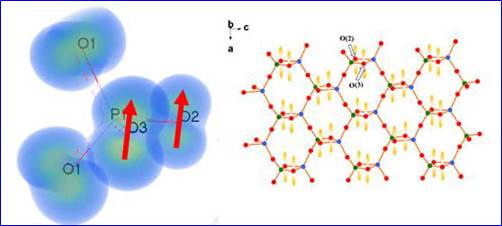Deep-ultraviolet (UV) nonlinear optical (NLO) materials have been widely used in laser and photonic technologies. The previously discovered NLO materials, such as β-BaB2O4, LiB3O5 and CsLiB6O10, show some drawbacks for practical usage. Therefore, the exploration and development of next generation deep-UV NLO materials are in great demand. However, it is still a challenge to explore satisfied deep-UV NLO materials possessing large second harmonic generation (SHG) response, wide deep-UV transparent window, and phase matching ability.
A research group led by Prof. PAN Shilie at Xinjiang Technical Institute of Physics & Chemistry of Chinese Academy of Sciences developed a promising deep-UV NLO material, LiCs2PO4, which was synthesized by the flux method. It crystallizes in the non-centrosymmetric and polar space group of Cmc21 (No. 36). The crystal structure can be described as two dimensional (2D) (LiPO4)2− layers along the a axis with the Cs+ cations residing between the layers. LiCs2PO4 exhibits an unusual edge-sharing LiO4 -PO4 tetrahedra connection, which is first found in alkali metal phosphates.
Researchers found the material achieves a new record of powder SHG response in deep-UV phosphates (2.6 times that of KH2PO4, and it also exhibits a short UV cutoff edge of 174 nm and is type–I phase-matchable, indicating that it can be used as a deep UV nonlinear optical material.
The large SHG response of LiCs2PO4 was quite unusual as it can’t contain additional anionic groups, and it was difficult to explain the origin of its large SHG response by using the anionic group concept alone. Researchers employed first-principles electronic structure analyses confirm the experimental results and the calculated SHG coefficients of LiCs2PO4 were d15 = d31 = −0.65 pm/V, d24 = d32 = 0.22 pm/V, and d33 = 0.61 pm/V.
In addition, the electronic structure was calculated to explore the intrinsic relationship between the structure and optical properties. The band-resolved method and orbital analysis indicate that the SHG enhancement of LiCs2PO4 was intimately associated with its unique structural feature, i.e., the edge-sharing LiO4-PO4 tetrahedra and aligned non-bonding O-2p orbitals.
The discovery and understanding of this material provide a new insight into the structure-property relationship of phosphate-based NLO materials with both large SHG response and deep-UV transparency.
The study was published as a communication in J. Am. Chem. Soc. This work was supported by the National Natural Science Foundation of China, the West Light Foundation of the Chinese Academy of Sciences, Xinjiang International Science & Technology Cooperation Program, etc.

Figure: Owing to the aligned non-bonding O-2p orbitals induced by unusual edge-sharing LiO4-PO4 tetrahedra connectivity, LiCs2PO4 exhibits a large SHG response of 2.6 times that of KDP (Image by XTIPC)
Contact:
Prof. PAN Shilie
E-mail: slpan@ms.xjb.ac.cn
Xinjiang Technical Institute of Physics & Chemistry,CAS
